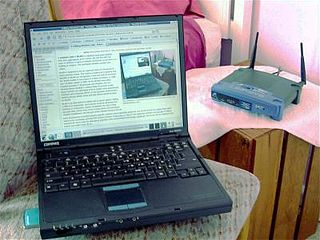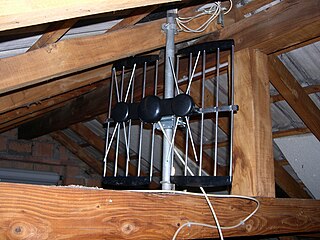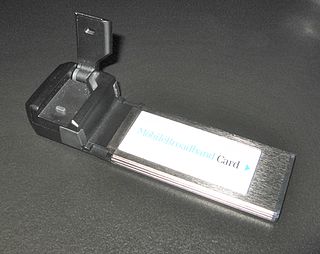
A wireless LAN (WLAN) is a wireless computer network that links two or more devices using wireless communication to form a local area network (LAN) within a limited area such as a home, school, computer laboratory, campus, office building etc. This gives users the ability to move around within the area and yet still be connected to the network. Through a gateway, a WLAN can also provide a connection to the wider Internet.

Ultra high frequency (UHF) is the ITU designation for radio frequencies in the range between 300 megahertz (MHz) and 3 gigahertz (GHz), also known as the decimetre band as the wavelengths range from one meter to one tenth of a meter. Radio waves with frequencies above the UHF band fall into the super-high frequency (SHF) or microwave frequency range. Lower frequency signals fall into the VHF or lower bands. UHF radio waves propagate mainly by line of sight; they are blocked by hills and large buildings although the transmission through building walls is strong enough for indoor reception. They are used for television broadcasting, cell phones, satellite communication including GPS, personal radio services including Wi-Fi and Bluetooth, walkie-talkies, cordless phones, and numerous other applications.

Internet access is the ability of individuals and organizations to connect to the Internet using computer terminals, computers, and other devices; and to access services such as email and the World Wide Web. Internet access is sold by Internet service providers (ISPs) delivering connectivity at a wide range of data transfer rates via various networking technologies. Many organizations, including a growing number of municipal entities, also provide cost-free wireless access.
Singtel Optus Pty Limited d/b/a Optus is the second largest telecommunications company in Australia and is a wholly owned subsidiary of Singaporean company Singtel. The company primarily trades under the Optus brand, while maintaining several wholly owned subsidiary brands, such as Virgin Mobile Australia in the mobile telephony market, Uecomm in the network services market and Alphawest in the ICT services sector.
Vidéotron is a Canadian integrated telecommunications company active in cable television, interactive multimedia development, video on demand, cable telephony, wireless communication and Internet access services. Owned by Quebecor, it primarily serves Quebec, as well as the Francophone communities of New Brunswick and some parts of Eastern Ontario. Its principal competitors are Bell Canada and Telus Communications.
A Mobile Network Operator or MNO, also known as a wireless service provider, wireless carrier, cellular company, or mobile network carrier, is a provider of wireless communications services that owns or controls all the elements necessary to sell and deliver services to an end user including radio spectrum allocation, wireless network infrastructure, back haul infrastructure, billing, customer care, provisioning computer systems and marketing and repair organizations.
4G is the fourth generation of broadband cellular network technology, succeeding 3G. A 4G system must provide capabilities defined by ITU in IMT Advanced. Potential and current applications include amended mobile web access, IP telephony, gaming services, high-definition mobile TV, video conferencing, and 3D television.
A mobile virtual network operator (MVNO) is a wireless communications services provider that does not own the wireless network infrastructure over which it provides services to its customers. An MVNO enters into a business agreement with a mobile network operator to obtain bulk access to network services at wholesale rates, then sets retail prices independently. An MVNO may use its own customer service, billing support systems, marketing, and sales personnel, or it could employ the services of a mobile virtual network enabler (MVNE).

A hotspot is a physical location where people may obtain Internet access, typically using Wi-Fi technology, via a wireless local area network (WLAN) using a router connected to an internet service provider.

Digitel Mobile Philippines, Inc., doing business as Sun Cellular, is a wholly owned subsidiary of Digital Telecommunications Philippines (Digitel), which in turn is owned by PLDT and is one of the Philippines’ largest mobile telecommunications companies. It was established by Digitel in September 2001 to provide wireless public and private telecommunications services. Sun Cellular is known for introducing unlimited call and text services in the Philippines.

Wireless security is the prevention of unauthorized access or damage to computers or data using wireless networks, which include Wi-Fi networks. The most common type is Wi-Fi security, which includes Wired Equivalent Privacy (WEP) and Wi-Fi Protected Access (WPA). WEP is a notoriously weak security standard: the password it uses can often be cracked in a few minutes with a basic laptop computer and widely available software tools. WEP is an old IEEE 802.11 standard from 1997, which was superseded in 2003 by WPA, or Wi-Fi Protected Access. WPA was a quick alternative to improve security over WEP. The current standard is WPA2; some hardware cannot support WPA2 without firmware upgrade or replacement. WPA2 uses an encryption device that encrypts the network with a 256-bit key; the longer key length improves security over WEP. Enterprises often enforce security using a certificate-based system to authenticate the connecting device, following the standard 802.1X.

CTIA is a trade association representing the wireless communications industry in the United States. The association was established in 1984 and is headquartered in Washington, D.C. It is a 501(c)(6) nonprofit membership organization, and represents wireless carriers and suppliers, and manufacturers and providers of wireless products and services.

Sierra Wireless is a multinational wireless communications equipment designer and manufacturer headquartered in Richmond, British Columbia, Canada. It also maintains offices and operations in California, France, Guangdong and Hong Kong.
A wireless ad hoc network (WANET) or Mobile ad hoc network (MANET) is a decentralised type of wireless network. The network is ad hoc because it does not rely on a pre-existing infrastructure, such as routers in wired networks or access points in managed (infrastructure) wireless networks. Instead, each node participates in routing by forwarding data for other nodes, so the determination of which nodes forward data is made dynamically on the basis of network connectivity and the routing algorithm in use.

Mobile broadband is the marketing term for wireless Internet access through a portable modem, USB wireless modem, or a tablet/smartphone or other mobile device. The first wireless Internet access became available in 1991 as part of the second generation (2G) of mobile phone technology. Higher speeds became available in 2001 and 2006 as part of the third (3G) and fourth (4G) generations. In 2011, 90% of the world's population lived in areas with 2G coverage, while 45% lived in areas with 2G and 3G coverage. Mobile broadband uses the spectrum of 225 MHz to 3700 MHz.

Freedom Mobile Inc. is a Canadian wireless telecommunications provider owned by Shaw Communications. With 1,578,358 active subscribers in urban areas of Ontario, British Columbia and Alberta, it is Canada's fourth largest mobile network operator with 5% market share.
Intel Mobile Communications (IMC), is the mobile research and development division of Intel. It was formed when Intel completed the acquisition of the Wireless Solutions (WLS) division of Infineon early in 2011 for US$1.4 billion. The Infineon subsidiary Comneon was also acquired by Intel and is now integrated into Intel Mobile Communications.
Network as a service (NaaS) describes services for network transport connectivity. NaaS involves the optimization of resource allocations by considering network and computing resources as a unified whole.











